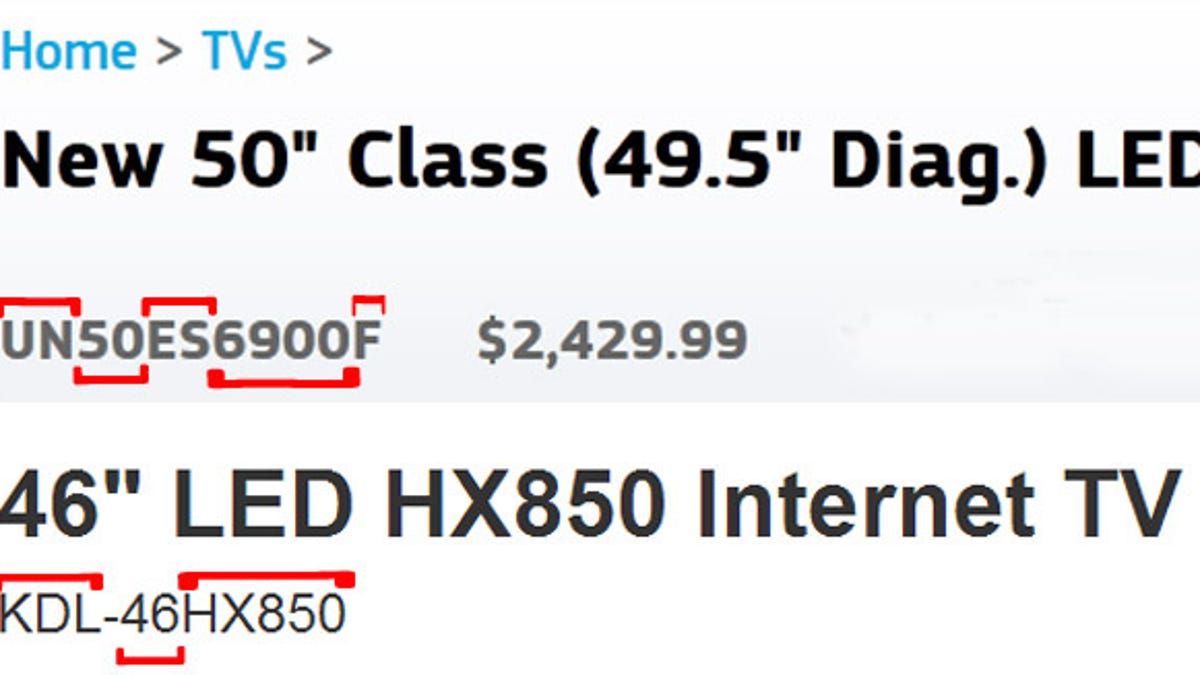What HDTV model numbers mean
There are not-so-hidden meanings in TV model numbers. Geoffrey Morrison helps you decode them, brand by brand.

One of the things I take for granted as a TV reviewer is the translation from model number to things like screen size, model line, display type, and so on.
I've gotten a few e-mails lately from people looking for help trying to decide between similarly priced models, with radically different model numbers. Are they similar? What does the alphanumerical soup mean?
While model numbers change yearly (or sometimes even more often), there are a few guidelines you can use to help you sort out the what from the what.
No list like this can be totally complete, but generally brands keep the "language" of their model numbers consistent. In some cases, companies make it easy for you to tell the current year's model, by keeping the series the same but changing one number to indicate the year. Panasonic is a good example of this: "VT50" is 2012, "VT30" is 2011.
Also, when I say "series" I'm talking about the family of TVs that a model belongs to. Generally, TVs within the same series will offer several different screen sizes, with the same features and similar specifications, while having somewhat similar performance.
LG 55LM6200
55: 55 inches diagonal. If you see two numbers together, for any brand, it's probably the size.
LM: Generally, this is the technology. LM is edge-lit LED LCD, LS is direct-lit (backlit) LED LCD, and CS regular LCD, PM and PA are plasma
6200: This is the series.
Panasonic TC-P65GT50
TC: Product category (televisions)
P: Technology. P for plasma, L for LCD
65: Size
GT: Series. The "T" in the series means it's 3D. So this TV is 3D, while the TC-L55E50 is not.
50: Year. "50" is 2012, "30" is 2011.
Samsung UN60ES7100F
UN: Technology. UN is LED LCD, LN is CCFL LCD, and PN is plasma. The "N" stands for North America.
60: Size
E: Year. "E" for 2012, "D" for 2011, "C" is for 2010. "C" is also for cookie.
S: A slim LED LCD model. This could be an "H" instead, for a deeper model.
7100: Series
F: Not, sure, actually...
Sharp LC-80LE844U
LC: Product category. "Liquid Crystal," presumably. Blu-ray players are BD, for example.
80: Size
LE: Type. LE is LED LCD, whereas SV is regular LCD.
844: Series.
U: For any company, this almost always means it's a U.S. model.
Sony KDL-40EX640
KDL: Display type/product category. LCD in this case, though you'll also see XBR for the high-end. "VPL" is its front projector prefix.
40: Size
EX: Series. Right now EX, BX, and HX.
640: Generally, year. For example, the HX929 is the 2011 model, the HX950 is the 2012 model. Due to carry-overs and other factors, this isn't a steadfast rule. Also, different models get released at different times during the year, so there's no easy "5" means 20XX or anything.
Toshiba 55L7200U
55: Size
L7200: Series
U: U.S.
Vizio M3D550SL
M: Series. You'll also see E for the lower-price models, and XVT for the top of the line.
3D: Yep, it means 3D
550: Size. Not sure why Vizio puts a 0 after the size, but all the current models have it.
SL: Various internal subcategories within the larger series. You'll also see VSE, KD, and others.
Lastly, if you find a TV that's got a weird model number, but seems identical to another TV with a number more in line with a company's nomenclature, it's probably an outlet-specific model. A lot of the warehouse clubs, like Costco, do this. For example, the TC-L55E54 is the Costco version of the TC-L55E50. These derivative models can be identical to the model they're based on, or they could be very slightly different, either with an additional feature (or lacking a feature) or slightly different cosmetics. Only close study of feature lists can reveal the difference (if any). There are many reasons companies do this, not least so that the store doesn't have to price match (as they're the only ones selling that exact model number).
Got a question for Geoff? Click "Geoffrey Morrison," then click the e-mail link in the upper right to e-mail, wait for it...Geoffrey Morrison! If it's witty, amusing, and/or a good question, you may just see it in a post just like this one. No, I won't tell you what TV to buy. Yes, I'll probably truncate and/or clean up your e-mail. You can also send me a message on Twitter: @TechWriterGeoff.

